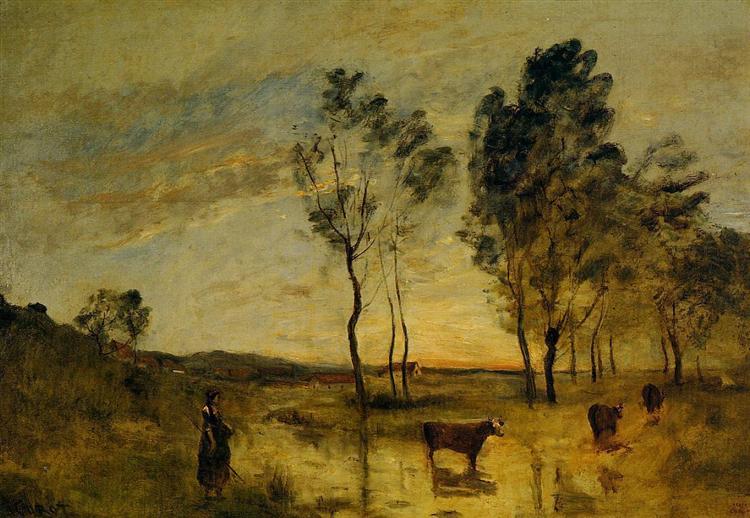Beskrivning
The work "Le Gue (Cows on the Banks of the Gue)", painted by Camille Corot in 1875, is a sublime exponent of the approach that the artist adopted throughout his career, combining the tradition of classical landscape painting with a more poetic and, at times, romantic sense. Corot, who was a pioneer of modern landscape, is distinguished by his ability to capture not only light and atmosphere, but also the very essence of the natural instrument and its interaction with everyday life. In this painting, the viewer is led into a pastoral world that emphasizes tranquility and simplicity.
The composition of the work is harmoniously organized from the placement of the elements on the canvas, where a group of cows is found grazing on the bank of a gently flowing river. The perspective opens generously, allowing the viewer's gaze to delve into the landscape. The cows, with their earthy brown color, blend in with the natural environment that surrounds them, creating a sense of unity and tranquility. In the background, there is a dense forest with trees that seem to embrace the scene, while a pale blue sky unfolds above everything, hinting at the passage of time and daylight.
The treatment of colour in Le Gue is one of its most outstanding aspects. Corot employs a palette that includes pleasant greens, blues and earth tones, using subtle gradations that infuse the work with a warm luminosity. Corot's characteristic loose brushstroke technique allows light to play across surfaces, suggesting an atmosphere of calm and serenity. This ability to capture natural light is a distinctive feature of his style, reflected in the famous motto of the Barbizon painters: “Nature is the instructor.”
As for the characters, although there are no human figures depicted in the scene, the cows themselves act as the central focus around which the composition revolves. Their presence enlivens the landscape, evoking a sense of life and activity. Corot, by not depicting humans, invites viewers to contemplate a world in which nature and animals coexist in harmony, a pastoral ideal that resonates throughout his work.
The painting is also significant in the context of the development of landscape in 19th-century European art. Corot, like other artists of the Barbizon School, sought to depict more than just the reproduction of the environment; they sought the essence and emotion of nature itself. His approach moved away from the rigidity of 19th-century academicism, delving into an emotional connection between the viewer and the landscape.
"Le Gue" is not only a representation of rural life, but also reflects the spirit of an era in which people were beginning to appreciate the beauty of nature in its purest form, far from the industrialisation and urban progress that surrounded them. This work, along with others by Corot, contributes to a legacy that would influence later generations of landscape painters, from the Impressionists to the Modernists.
In conclusion, “Le Gue (Cows on the Banks of the Gue)” is a testament to Camille Corot’s genius and his ability to translate the stillness of nature into a vibrant and evocative work of art. Through his compositional ingenuity and masterful use of color, Corot not only captures the beauty of the landscape, but also invites the viewer to a deeper reflection on our connection with the natural environment. In this sense, the work continues to be relevant, inspiring admiration and contemplation in those who appreciate it.
KUADROS ©, a famous painting on your wall.
Hand-made oil painting reproductions, with the quality of professional artists and the distinctive seal of KUADROS ©.
Painting reproduction service with satisfaction guarantee. If you are not completely satisfied with the replica of your painting, we will refund 100% of your money.

